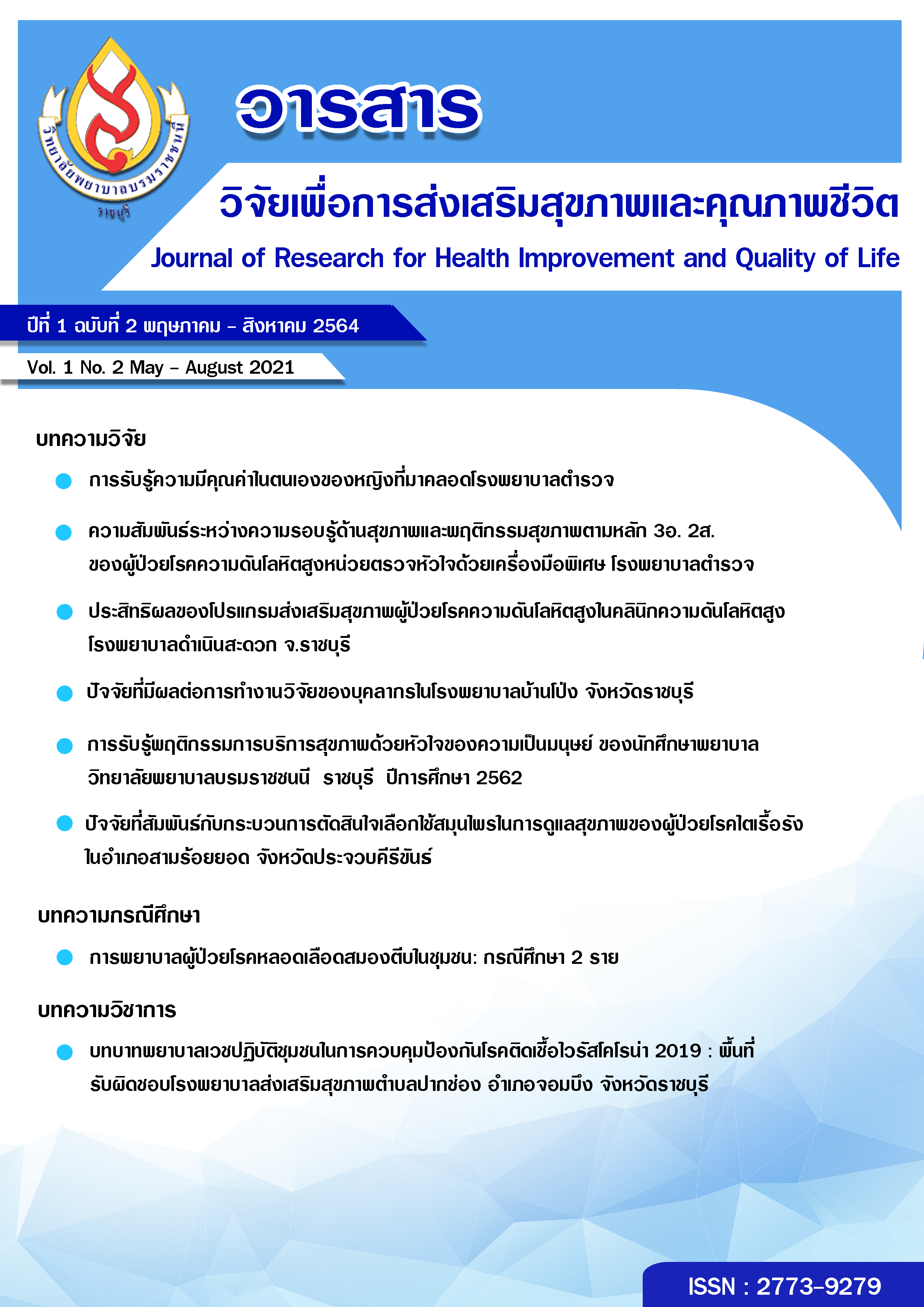ประสิทธิผลของโปรแกรมส่งเสริมสุขภาพผู้ป่วยโรคความดันโลหิตสูงในคลินิกความดันโลหิตสูง โรงพยาบาลดำเนินสะดวก จ.ราชบุรี
คำสำคัญ:
โปรแกรมส่งเสริมสุขภาพ, พฤติกรรมส่งเสริมสุขภาพ, ผู้ป่วยโรคความดันโลหิตสูงบทคัดย่อ
การวิจัยครั้งนี้มีวัตถุประสงค์เพื่อเปรียบเทียบความรู้ พฤติกรรมส่งเสริมสุขภาพ และค่าเฉลี่ยความดันโลหิตของผู้ป่วยโรคความดันโลหิตสูงก่อนและหลังเข้าร่วมโปรแกรมส่งเสริมสุขภาพ กลุ่มตัวอย่างเป็นผู้ป่วย โรคความดันโลหิตสูงในคลินิกความดันโลหิตสูง โรงพยาบาลดำเนินสะดวก จำนวน 30 ราย เครื่องมือที่วิจัย แบ่งเป็น 3 ส่วน ได้แก่ โปรแกรมส่งเสริมสุขภาพในผู้ป่วยความดันโลหิตสูง แบบสอบถามความรู้เกี่ยวกับโรคความดันโลหิตสูง ตรวจสอบความเที่ยงโดยใช้สูตร KR 20 เท่ากับ 0.77 และแบบสอบถามพฤติกรรมส่งเสริมสุขภาพ ความเที่ยงด้วยการใช้สูตรสัมประสิทธิ์แอลฟ่าของครอนบาค เท่ากับ 0.86 วิเคราะห์ข้อมูลด้วยการใช้สถิติพรรณนา ได้แก่ ความถี่ ร้อยละ ค่าเฉลี่ย และส่วนเบี่ยงเบนมาตรฐาน สถิติอ้างอิง ได้แก่ การทดสอบที ผลการวิจัย พบว่า
1. การเปรียบเทียบคะแนนเฉลี่ยความรู้ พบว่า หลังเข้าร่วมโปรแกรมผู้ป่วยมีคะแนนเฉลี่ยความรู้สูงกว่าก่อนเข้าร่วมโปรแกรมอย่างมีนัยสำคัญทางสถิติ (M=60, SD= 2.85; M= 20.60, SD=7.14; p< 0.01) ตามลำดับ
2. การเปรียบเทียบคะแนนเฉลี่ยพฤติกรรมส่งเสริมสุขภาพ พบว่า หลังจากเข้าร่วมโปรแกรมผู้ป่วยมีคะแนนเฉลี่ยพฤติกรรมส่งเสริมสุขภาพสูงกว่าก่อนเข้าร่วมโปรแกรมอย่างมีนัยสำคัญทางสถิติ (M=14, SD=0.50; M=3.76, SD=0.53; p< 0.01)
ผลการวิจัยเบื้องต้นแสดงให้เห็นว่าโปรแกรมส่งเสริมสุขภาพเป็นรายบุคคลสามารถเสริมสร้างพฤติกรรมส่งเสริมสุขภาพของผู้ป่วยให้ดียิ่งขึ้น จึงควรนำไปพัฒนาให้สมบูรณ์และดำเนินการวิจัยต่อเพื่อประโยชน์ในการนำมาใช้ปฏิบัติ
เอกสารอ้างอิง
Best, J. W. (1977). Research in Education. (3rd ed). New Jersey: Prentice hall Inc.
Department of Disease Control. (2018). Pressure day campaign issue world high blood pressure, year 2018. Retrieved March 10, 2021 from http://www.thaincd.com/document/file/info/non-communicable-disease. (In Thai)
Medical records at Damnoen Saduak Hospital. (2019). Indicator statistics report for the year 2019. (In Thai)
Information and Communication Technology Center, Office of the Permanent Secretary, Ministry of Public Health (2017). Knowledge for self-management of hypertension. Bangkok: Office of Printing Works Organization Veterans Relief. (In Thai)
Suaetoo, N., Jirapongsuwan, A., Rawiworrakul, T., Tipayamongkholgul, M. (2018) . The effect of a program to promote blood pressure control among 35 to 59 years-old patients with uncontrolled hypertension. Journal of Public Health Nursing, 32(2), 95-115. (In Thai)
Sumthong, P., Suthiphongkiart, B., Kleebpratoom, P. & Oadpakdee, W. (2019). The effect of home blood pressure monitoring program applying transtheoretical model and social support power in hypertensive patients, Angthong Hospital. Journal of Prachomklao College of Nursing, Phetchaburi Province. 2(1), 1-14. (In Thai)
Maklumdam, P. (2015). The effects of health promotion on self-care behavior for the elderly patients with hypertension. Phranakhon Rajabhat Research Journal, 10(1), 20-39. (In Thai)
Pender, N. J., Murdaugh, C. L., & Parsons, M. A. (2011). Health promotion in nursing practice (6th ed.). New Jersey: Prentice-Hall.
Wiratchai, N. (2012). Determination of sample size and the new interesting statistical analysis. Retrieved March 11, 2021 from https://lllskill.com/web/files/GPower.pdf. (In Thai)
Nakklin, Y. & Thatsri, P. (2017) .Effects of self-efficacy promotion program on healthy behavior of the elderly with hypertension whose blood pressure level cannot be controlled. Apheit Journal, 6(1), 27-35. (In Thai)
World Health Organization. (2013). A global brief on hypertension silent killer, global public health crisis. Retrieved February 23, 2021 from http://www.who.Cardiovascular_ diseases/publications/global_brief_hypertension.
ดาวน์โหลด
เผยแพร่แล้ว
ฉบับ
ประเภทบทความ
สัญญาอนุญาต
ลิขสิทธิ์ (c) 2021 วิทยาลัยพยาบาลบรมราชชนนี ราชบุรี

อนุญาตภายใต้เงื่อนไข Creative Commons Attribution-NonCommercial-NoDerivatives 4.0 International License.
บทความทีตีพิมพ์ในวารสารนี้ถือว่าเป็นลิขสิทธิ์ของวิทยาลัยพยาบาลบรมราชชนนี ราชบุรี และผลงานวิชาการหรือวิจัยของคณะผู้เขียน ไม่ใช่ความคิดเห็นของบรรณาธิการหรือผู้จัดทํา




